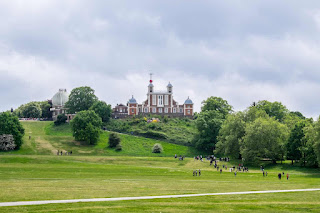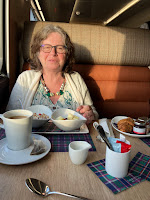Youngest sister suggested that we visit the NPL in Teddington as this was about to have its annual day when ordinary members of the public could enter and look around the site for the princely fee of £3 each. Accordingly my youngest brother, his wife, youngest sister, mrs maytrees and myself all agreed to accompany youngest sister to look at the NPL.
Years ago when I was still at Beaumont College as a schoolboy, our physics teacher, Father Michael Ross SJ used to go to the NPL on occasion as did my father when some years prior to that he had been a Royal Air Force officer. I recall he had been working on the long since cancelled British rocket known then as Blue Streak.
In those days the site's buildings were all rather older than they are now, with the site having been established in c. 1900. The current buildings were apparently erected in the 1980s and to my eye at least are not unattractive.
Traveling to the NPL was easy enough. Train directly from Raynes Park to Teddington for some 12 minutes, then a walk of 20 minutes or so to the NPL. Mrs maytrees was in the event, unfortunately unable to come, but might have enjoyed the visit including as it did, use of the scientists' subsidised refectory and cafe.
Most of the scientists seemed to be young, highly qualified and skilled. They were excellent too in explaining the many features at the site, including liquid nitrogen,optical atomic clocks, quantum light and electronic reliability in harsh environments.
Photography was generally not permitted but one young technician was pleased to photograph me near to an atomic clock:
She told me that Greenwich Mean Time measuring, has long since been replaced by atomic clocks, though GMT based at Greenwich is still used for example for the annual switch to British Summertime, BST.
For me the most interesting aspect of the visit was the lecture entitled How Long is a Piece of String which was given to quite a number of people, including yours truly, in a large comfortable lecture hall.
The half an hour lecture covered such topics as black holes, the possible beginning of our universe, different types of burning and flames. The excellent speaker took a number of questions at the end of his talk.
Overall an unusual and interesting day.
























No cattle truck type experience as on planes, nor traffic jams as on roads.
Whereas as indicated earlier, nearly all the other comments were critical, for example a longer one reading:
When the new Caledonian Sleeper carriages were introduced in 2019, they included en-suite rooms and other upgrades. However, these features came at the cost of reducing space elsewhere in the train, the berths and corridors are claustrophobically narrow.The new Caledonian Sleeper carriages are noisier and less comfortable, made from lighter modern materials with less effective suspension, and poor acoustic insulation compared to the old sleepers. Worn out tracks, maintenance problems exacerbate rattling and vibrations, loose fittings inside carriages add to the noise. The older trains were heavier and better tested for smoother travelling, making them quieter and more enjoyable. The current carriages prioritise efficiency and capacity over passenger comfort, which might explain why fewer people choose to travel on this train again.
Possibly many today moan more about many things, than did the generation born before, during or just after after WWII when there was eg still food rationing in the 1950s.
For the remainder of this blog post there are posted pictures of the Caledonian Sleeper.
Details of our very interesting and enjoyable stay in Aberdeen will hopefully,follow next week.